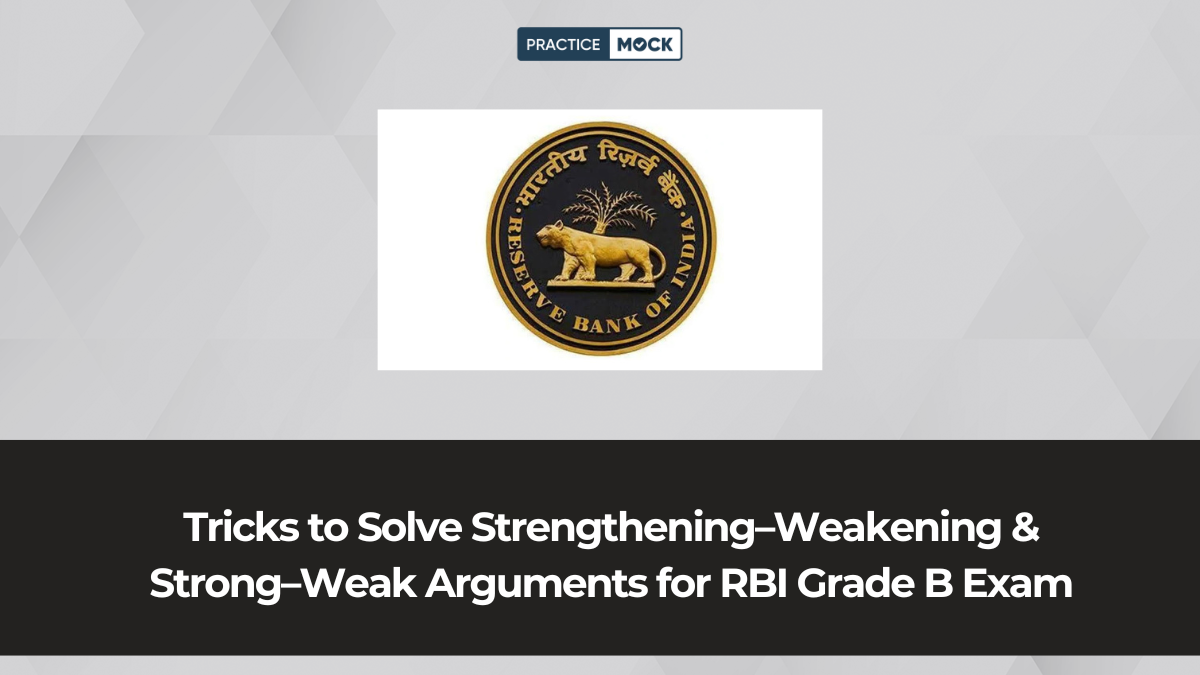Strengthening–Weakening Statements and Strong–Weak Arguments are two of the most common critical reasoning question types in the RBI Grade B Phase 1 exam, under the Reasoning section. These questions are based on arguments, and candidates who understand them get an edge. In strengthening–weakening questions, you are asked to find which option makes the argument stronger or weaker. In strong–weak argument questions, you must decide whether a given reason is strong or weak in support of an action. These topics help boost reasoning scores and increase confidence in logical thinking.
Click Here to Check PIB Sutra & Master Current Affairs
Easy Tips to Master Strengthening & Weakening Questions
Many students struggle with these topics because they try to use their personal opinions or don’t understand how arguments work. These simple tips will help you approach such questions smartly and solve them with ease.
Tip 1: Understand What an Argument Means
Know that an argument includes a claim and the reason behind it.
- Always identify the main claim.
- Look for evidence or reasons given.
- Don’t bring in outside knowledge.
- Focus only on the statement given.
- Keep emotion out of it.
Tip 2: Spot the Strengthener or Weakener
Look for how the options affect the argument’s strength.
- A strengthener supports the argument’s logic.
- A weakener shows a flaw or counterpoint.
- Eliminate neutral or unrelated options.
- Think logically, not emotionally.
- Avoid extreme or vague options.
Tip 3: Know What Makes an Argument Strong
A strong argument is logical and relevant to the issue.
- Check if the reason clearly supports the action.
- Avoid opinions and assumptions.
- Strong arguments are fact-based.
- Relevance is key.
- Clarity makes an argument strong.
Tip 4: Identify a Weak Argument Quickly
Weak arguments are often vague, emotional, or off-topic.
- Look for reasons that don’t connect well.
- Avoid emotional or moral appeals.
- Vague or general ideas are weak.
- Spot irrelevant facts.
- Unsupported claims are weak.
Tip 5: Practice and Analyze Carefully
Regular practice helps in spotting logic errors quickly.
- Solve past year questions.
- Review all your wrong answers.
- Discuss logic with peers.
- Read answer explanations.
- Practice in timed settings.
Practice Questions on Strengthening-Weakening Statements
Directions: In the question given below, a passage/statement is given followed by three statements which may or may not strengthen/weaken the assertion made in the passage. Answer the questions as per the individual direction given.
As the effects of global warming worsen due to increasing carbon emissions, throwing a sun screen around the globe could be a possible solution in a last-ditch attempt at fending off disaster. The proposition includes lacing our stratosphere with additional reflective sulphate aerosols to keep out exactly as much sun rays as we need for a recovery.
Which of the following, if true, would strengthen the argument made in the given paragraph?
1. The aerosols would not meddle much with our weather patterns, ocean currents and marine life as they would be far up in the sky.
2. The UNFCCC has found that sulphate aerosols remain in the atmosphere for only a short amount of time, and therefore their cooling is localised and temporary.
3. Sulphate aerosols diffuse sunlight which leads to increased productivity by increasing the light availability to a larger fraction of the canopy and therefore enhance terrestrial carbon uptake.
a) Only 3
b) Only 1 and 2
c) Only 2 and 3
d) Only 1 and 3
e) All 1, 2 and 3
Ans: D
Solution: The passage talks about injecting reflective sulphate aerosols in the stratosphere to control global warming. It tells us how the aerosol layer in the atmosphere will reflect exactly as much sun rays as we need for recovering from the effects of global warming. 1 tells us how these aerosols would not interfere with our weather pattern, ocean currents and marine life. 3 tells us how diffused sunlight due to sulphate aerosols could increase carbon absorption by terrestrial plants and hence help in controlling global warming. Both 1 and 3 are correct. Thus, D is the right answer.
2 does not favour the argument as it tells us how the cooling effect of sulphate aerosols is localised and temporary.
In India, annual rate of speed limit violations in states with strict traffic violation laws were about 50 percent higher than the eleven states where strict traffic violations laws have never been passed. Thus one way to reduce speed limit violations is to repeal strict traffic violation laws.
Which of the following, if true, would most weaken the argument above?
a) In states with strict traffic violation laws, few individuals are fined for violating such laws.
b) In states without strict traffic violation laws, many individuals have never gone to a driving school.
c) The annual rate of speed limit violations is lower in states with strict traffic violation laws than in states without such laws.
d) Less than half of the individuals who reside in states without strict traffic violation laws own a vehicle.
e) None of the above
Ans: (d)
Solution: (d) is the right answer. The premise tells us that there are more speed limit violations in states where there are strict traffic violation laws than the ones where these laws were not passed. The conclusion drawn from this data is that we should repeal these laws in order to reduce the incidents of speed limit violations in the states which have passed these laws. D tells us that less than half of the individuals who reside in states without strict traffic violation laws own a vehicle. This seriously weakens the above conclusion since it brings into question the data on which the conclusion is based. If less people own vehicles then it is likely that less number of people would violate the speed limits. The data does not provide us with actual numbers, it merely tells us that the percentage by which speed limit violations in states that have strict laws is higher than those states which do not have these laws.
A and B are incorrect as it is unrelated to the argument. C is incorrect as it contradicts the data given in the premise.
A study conducted by LANCET aimed at studying children’s television-watching habits during the lockdown found that children aged 7-12 who watched more than 20 hours of television per week performed worse in school than children of the same age who watched fewer than 20 hours of television per week. Therefore, parents of children aged 7-12 should not allow their children to watch more than 20 horse of television per week
Which of the following, if true, would be best to strengthen the argument above?
a) Another study has found that limiting exposure to gadgets may increase children’s reading scores significantly.
b) The LANCET study also found that children who watched more than 20 hours of television fared poorly on measures of physical fitness.
c) The television shows that are popular among the 7-12 year olds are of little educational value.
d) The study considered children belonging to different backgrounds and was representative of the children across the country.
e) None of the above
Ans: (d)
Solution: (d) is the right answer. It tells us that the study accurately represents the children across the country and it takes into account the diverse background to which they may belong.
A is incorrect as it talks about gadgets while the passage talks about television.
B is incorrect because the passage talks about academic performance and not physical fitness.
C is incorrect because it adds nothing to the argument that parents should limit the number of hours their children spend watching television.
In rural areas, one of the major issues is the rise in absenteeism of students. Experts believe that poor attendance is a byproduct of lack of inspiration. Thus, there is a need to change the mindset of the students in order to improve their attendance. Schools should focus on policies that improve students’ learning at school rather than making stricter attendance policies.
Which of the following, if true, would most effectively weaken the experts’ argument?
a) Students can seek inspiration from their parents at home.
b) The amount of interest in learning that a student develops is determined by the amount of time he/she spends in the classroom.
c) Students should behave more responsibly in the classroom.
d) Motivation is an important determinant of academic success.
e) None of the above
Ans: (b)
Solution: (b) is the right answer. The premise tells us that the author believes that low attendance is caused by lack of motivation. However, B tells us that interest in academics results from time spent in class. Thus, it changes the cause and effect relationship between the two events. It seriously weakens the argument above. The other options are simply irrelevant to the premise of the argument.
Practice Questions on Strong-weak Arguments
Directions: Each question given below consists of a statement, followed by two arguments numbered I and II. You have to decide which of the arguments is a ‘strong’ argument and which is a ‘weak’ argument.
Statement: Should developed countries bear greater financial liability for combating global warming than developing countries?
I. Yes because all countries emit greenhouse gases responsible for global warming, but developed countries emit significantly greater quantities than others.
II. Yes, because developed countries have more capital to achieve this objective than developing countries do.
a) Only argument I is strong
b) Only argument II is strong
c) Either I or II is strong
d) Neither I nor II is strong
e) Both I and II are strong
Ans: E
Solution: Both I and II are strong arguments. 1 justifies the claim that developed countries should be made to bear greater financial liability for combating global warming, on the premise that they have played a greater role in causing global warming than developing countries have. II justifies the claim on the basis that developed countries have more capital to successfully achieve this goal. Thus, E is the right answer.
Takeaway
As we discussed above, after you understand the logic behind the arguments, you will solve these questions confidently.
To summarize, you need to:
- Focus on logic, not emotions
- Don’t assume anything outside the question
- Keep your reasoning clear and simple
- Practice daily with past papers
- Keep practicing and stay confident
In short, a clear understanding and regular practice will help you make strengthening–weakening, and argument questions your strength in the RBI Grade B exam.

FAQs
It supports or adds value to the given argument.
A logical, relevant, and fact-based reason.
No, only use the information given in the question.
A reason that is illogical, vague, or unrelated.
No, they are usually part of Phase 1 Reasoning.
- Sign Up on Practicemock for Updated Current Affairs, Free Topic Tests and Free Mini Mocks
- Sign Up Here to Download Free Study Material
Free Mock Tests for the Upcoming Exams
- IBPS PO Free Mock Test
- RBI Grade B Free Mock Test
- IBPS SO Free Mock Test
- NABARD Grade A Free Mock Test
- SSC CGL Free Mock Test
- IBPS Clerk Free Mock Test
- IBPS RRB PO Free Mock Test
- IBPS RRB Clerk Free Mock Test
- RRB NTPC Free Mock Test
- SSC MTS Free Mock Test
- SSC Strenographer Free Mock Test
- GATE Mechanical Free Mock Test
- GATE Civil Free Mock Test
- RRB ALP Free Mock Test
- SSC CPO Free Mock Test
- AFCAT Free Mock Test
- SEBI Grade A Free Mock Test
- IFSCA Grade A Free Mock Test
- RRB JE Free Mock Test
- Free Banking Live Test
- Free SSC Live Test




